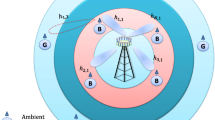Abstract
Recently, ambient backscatter attracts much attention since it can utilize ambient radio frequency signals to enable battery-free devices to communicate with others. Most existing studies about ambient backscatter assume that the reader is equipped with one receiving antenna. In practice, the reader can utilize multiple antennas to overcome channel fading. In this paper, we investigate the problem of signal detection for ambient backscatter systems with multiple receiving antennas. Specifically, we formulate a new transmission model where the reader is equipped with at least two antennas and propose a ratio detector that exploits the ratio of the signal strength received at each antenna. It is shown that the closed-form expression of the optimal detection threshold for this detector is difficult to derive. Therefore, we derive a reasonable approximate expression for the optimal detection threshold. Moreover, we obtain the closed-form expression for approximate bit error rate (BER). Furthermore, we propose an antenna selection scheme if the reader is equipped with more than two antennas. The selection scheme is investigated through the BER performance. It is found that the largest gain in BER can be achieved when the antenna number increases from two to three, and that much less gain is obtained from enlarging the antenna number when the reader already has four antennas. Finally, simulation results are provided to corroborate our theoretical studies.









Similar content being viewed by others
Notes
which is difficult but achievable
References
Dobkin DM (2008) The RF in RFID: passive UHF RFID in practice. Elsevier, Newnes, pp 1133–1138
Kuester D, Popovic Z (2013) How good is your tag? RFID backscatter metrics and measurements. IEEE Microwave 14(5):47–55
Liu V, Parks A, Talla V, Gollakota S, Wetherall D, Smith JR (2013) Ambient backscatter: wireless communication out of thin air. In: Proceedings of the ACM SIGCOMM, pp 1–13
Kellogg B, Parks A, Gollakota S, Smith JR, Wetherall D (2014) Wi-fi backscatter: internet connectivity for RF-powered devices. In: Proceedings of the ACM SIGCOMM, pp 1–12
Gollakota S, Reynolds MS, Smith JR, Wetherall D (2014) The emergence of RF-powered computing. IEEE Computer 47(1):32–39
Vyas RJ, Cool BB, Kawahara Y, Tentzeris MM (2013) E-WEHP: a batteryless embedded sensor-platform wirelessly powered from ambient digital-TV signals. IEEE Trans Microw Theory Tech 61(6):2491–2505
Parks A, Liu A, Gollakota S, Smith JR (2014) Turbocharging ambient backcatter communications. In: Proceedings of the ACM SIGCOMM, pp 1–12
Zhang H, Jiang C, Bea ulieu N, Chu X, Wang X, Quek T (2015) Resource allocation for cognitive small cell networks: a cooperative bargaining game theoretic approach. IEEE Trans Wireless Commun 53(3):158–164
Zhang Z, Chai X, Long K, Vasilakos AV, Hanzo L (2015) Full-duplex techniques for 5G networks: self-interference cancellation, protocol design and relay selection. IEEE Commun Magazine 53(5):128–137
Bharadia D, Joshi KR, Kotaru M, Katti S (2015) Backfi: high throughput wifi backscatter. In: Proceedings of the ACM SIGCOMM, pp 1–14
Lyer V, Talla V, Kellogg B, Gollakota S, Smith JR (2016) Inter-technology backscatter: towards internet connectivity for implanted devices. In: Proceedings of the ACM SIGCOMM, pp 356–369
Wang G, Gao F, Fan R, Tellambura C (2016) Ambient backscatter communication systems: detection and performance analysis. IEEE Trans Commun 64(11):4836–4846
Kang L, Wang G, Qu F, Zhong Z (2015) Signal detection and BER analysis for RF-powered devices utilizing ambient backscatter. In: Proceedings of the wireless communications & signal processing (WCSP), pp 1–5
Wang G, Gao F, Dou Z, Tellambura C (2015) Uplink detection and BER analysis for ambient backscatter communication systems. In: Proceedings of the IEEE globecom, pp 1–6
Qian J, Gao F, Wang G (2016) Signal detection of ambient backscatter system with differential modulation. In: Proceedings of the IEEE ICASSP, pp 3831–3835
Zeng T, Wang G, Wang Y, Zhong Z, Tellambura C (2016) Statistical covariance based signal detection for ambient backscatter communication systems. In: IEEE vehicular technology conference: Vtc2016-fall
Qian J, Gao F, Wang G, Jin S, Zhu H (2017) Noncoherent detections for ambient backscatter system. IEEE Trans Wireless Commun 16(3):1412–1422
Xing C, Ma S, Zhou Y (2015) Matrix-monotonic optimization for MIMO systems. IEEE Trans Signal Process 63(2):34–348
Ma Z, Wang G, Gao F, Zhong Z (2015) Signal detection for ambient backscatter communication systems with multiple receiving antennas. In: Proceedings of the IEEE canadian workshop on information theory (CWIT), pp 1–4
Gao F, Cui T, Nallanathan A (2008) On channel estimation and optimal training design for amplify and forward relay network. IEEE Trans Wireless Commun 7(5):1907–1916
Gao F, Zhang R, Liang Y-C (2009) Optimal channel estimation and training design for two-way relay networks. IEEE Trans Commun 57(10):3024–3033
Yang F, Song J, Pan C, Yang Z (2007) EM-Based estimation of doubly selective channel with a basis expansion model. In: IEEE proceedings of international conference on communications, circuits and systems proceedings, pp 620– 623
Ma S, Wang G, Gao F (2017) Blind channel estimation for ambient backscatter communication systems. To be submitted
Simon MK (2002) Probability distributions involving Gaussian random variables. Springer, Berlin, p 70
Zhang H, Chu X, Guo W, Wang S (2015) Coexistence of Wi-Fi and heterogeneous small cell networks sharing unlicensed spectrum. IEEE Commun Magazine 53(3):158–164
Acknowledgements
This study is supported by the National Natural Science Foundation of China (No. 61571037), by the Fundamental Research Funds for the Central Universities (No.2016JBZ006 and No.2017YJS040), and by Technology & Innovation/Research/Radio system Beijing, Nokia Company.
Author information
Authors and Affiliations
Corresponding author
Rights and permissions
About this article
Cite this article
Ma, S., Wang, G., Wang, Y. et al. Signal Ratio Detection and Approximate Performance Analysis for Ambient Backscatter Communication Systems with Multiple Receiving Antennas. Mobile Netw Appl 23, 1478–1486 (2018). https://doi.org/10.1007/s11036-017-0980-0
Published:
Issue Date:
DOI: https://doi.org/10.1007/s11036-017-0980-0




